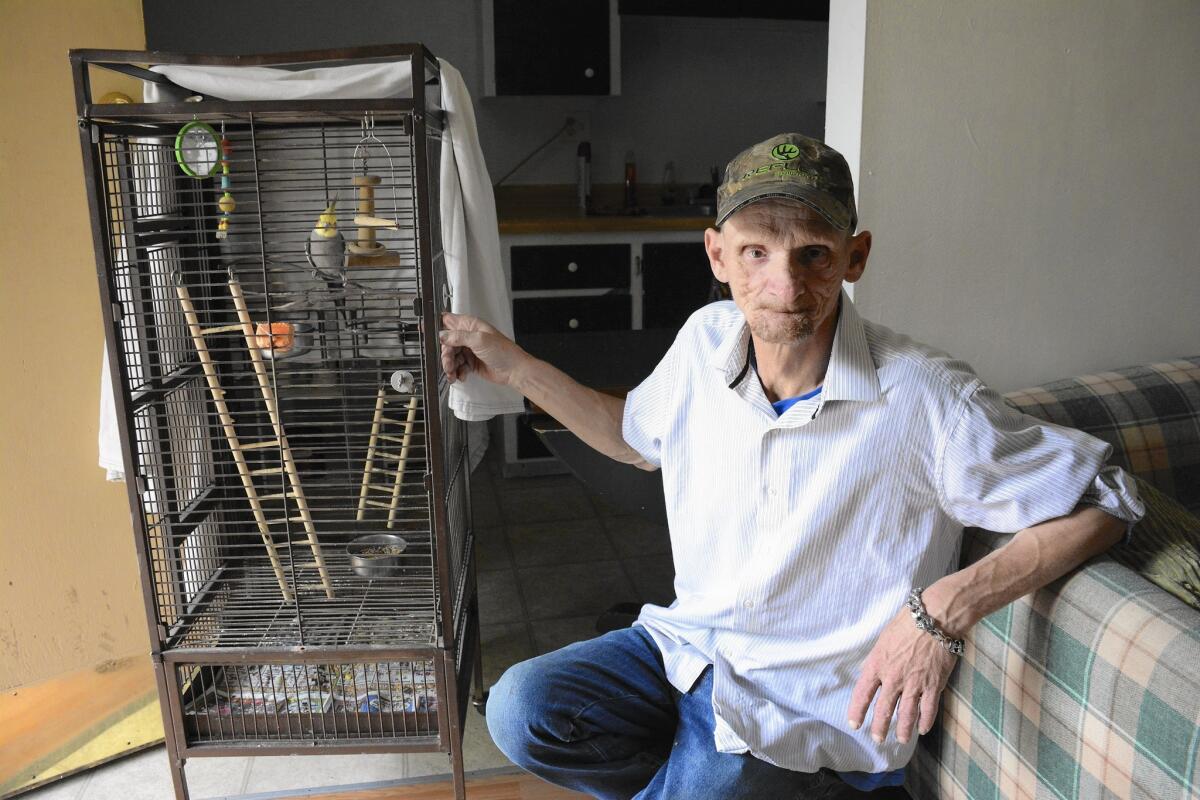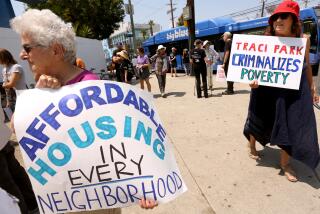Utah is winning the war on chronic homelessness with ‘Housing First’ program

Reporting from SALT LAKE CITY — Terry Birch recalls walking cautiously into the tiny one-bedroom apartment seven months ago, like a cat exploring a box, or something wild fearful of a trap.
After two decades on the streets, he finally had a real roof over his head, a home to call his own. It was clean, private and safe, but also scary and confusing.
“I couldn’t get used to the four walls. It felt like they were closing in on me,” he said, sitting in the living room of unit No. 2 at the
Metro Apartments. “On the streets, I had no responsibility, other than keeping myself clean.”
He paused, surveying his surroundings: “And then this.”
This is “Housing First,” a novel effort by Utah to attack an intractable social ill. The state provides apartments to the chronically homeless and worries about addressing the underlying causes, such as drug abuse, later. By allowing bodies to rest and heal, housing officials say, emotional health will probably follow.
------------
FOR THE RECORD:
Utah homeless: In the May 24 Section A, an article about Utah’s program to house the chronically homeless referred to the pet bird one resident took in as a cockatoo. It’s a cockatiel. —
------------
Last month, officials announced that they had reduced by 91% the ranks of the chronically homeless — defined as someone who has spent at least one year full-time on the streets — and are now approaching “functional zero.”
In 2005, when state officials began placing people in permanent housing, they counted 1,932 chronically homeless. Today, with 1,764 people housed, that number has plummeted to just 178 statewide. And officials have their sights set on those remaining.
“We know these individuals by name, know their situation,” said Gordon Walker, director of the state Housing and Community Development Division. “And we can help them move out of chronic homelessness, if they choose.”
The program contrasts with approaches elsewhere. Police in Tampa, Fla., for example, arrest those caught sleeping or storing property in public. Philadelphia bans the feeding of homeless in city parks. A study by UC Berkeley Law students found that California has more anti-homeless laws on average than other states, punitive local ordinances targeting the homeless for standing, sitting or resting in public.
But not Utah.
“People once had to change their lives to become housed,” Walker said. “Now we give them housing first so they can make changes if they want to.”
Studies showed that Utah’s chronically homeless — while a fraction of an overall homeless population of 14,000 — used 60% of the services for those living on the streets.
The cost of providing an apartment and social work for clients in the Housing First program is $11,000 annually, while the average price of hospital visits and jail for street denizens is nearly $17,000 a year.
In Housing First, clients pay $50 a month or 30% of their income, whichever is more. Said Walker: “It’s not just more compassionate — it’s cheaper.”
But there’s a curious consequence of coaching people to finally leave the streets: Many aren’t used to having their own private domain.
One man spent his first few nights sleeping on the floor, heaping his belongings atop his donated bed. Another pitched a tent in his living room for two weeks. Others go months or years before taking real ownership of their new home by doing things like hanging pictures or raising a pet, or even a potted plant.
“We don’t see a lot of breathless excitement when they first move in,” said Kevin Austin, a housing supervisor at a nonprofit called the Road Home, who has helped get more than 300 chronically homeless people into apartments. “I’d say the most common reaction is nervousness, like, ‘You guys are leaving me here?’”
Birch knows the feeling.
At 53, his teeth missing and body racked by exposure and substance abuse, Birch at first welcomed the apartment. “I couldn’t believe I could get what I’d always wanted,” he said. An abusive stepfather had long ago forced him onto the streets, he said, where he learned to fend off thieves. Recently, he lived in a tent pitched on a steep hillside.
But after moving into an apartment with food in the refrigerator and clean sheets on the bed, he no longer knew how to define home: Was it a place to store his belongings, or a space to nurture his sense of self? At first, he let street friends inside for raucous parties, testing the patience of overseers.
“I never thought I’d be here that long,” Birch said.
Then two things happened. First, he was diagnosed with leukemia, which reduced his 6-foot-2 frame to just 120 pounds. Then relatives said they were going to put their cockatoo, Buddy, on the street — and the onetime homeless man took in a fellow lost creature.
“He’s been a lot of company to me, even if he has been a bit grumpy lately,” Birch said, gently poking a finger into Buddy’s cage. And the apartment helped him cope with the weariness from his cancer.
Birch began to care for his 400-square-foot unit, as well as himself. He quit
alcohol and is working to give up cigarettes. His place has a personal touch: a flat-screen TV and a shelf crowded with books by James Patterson and other mystery writers.
Over his couch, Birch has hung something he could never have had at any temporary shelter: a photo collage of his mother and sisters, with the word “family” written in large letters.
Still, he admits, he gets lonely. “But this is my home,” he said. “If anything goes wrong, it concerns me.”
His voice catches. “Without this place, I wouldn’t be alive. I’m still afraid someone is going to take it away from me.”
Walker wishes more people showed such promise. He said the program claims an 85% success rate, with some clients being evicted for breaking the rules. Others just walk away.
“Not as many as we would have liked have changed their lives,” he said. “There are a few ‘trappers and hunters’ out there who really do choose what they call freedom.”
The Housing First model would be expensive for other locations — a recent estimate put the chronically homeless population in Los Angeles County at about 12,300 — but Walker’s office has received visits from officials from cities in Tennessee and South Carolina.
“We’re not saying this is a one-size-fits-all solution for chronic homelessness,” Walker said. “But now we’re finally asking ourselves: Can we really bring an end to something like this? I hope so.”
So does Birch, who now uses a phrase he hasn’t known since childhood: home sweet home.
He waves his hand around his living room: “Not bad for an old bum like me.”
Twitter: @jglionna
More to Read
Sign up for Essential California
The most important California stories and recommendations in your inbox every morning.
You may occasionally receive promotional content from the Los Angeles Times.











